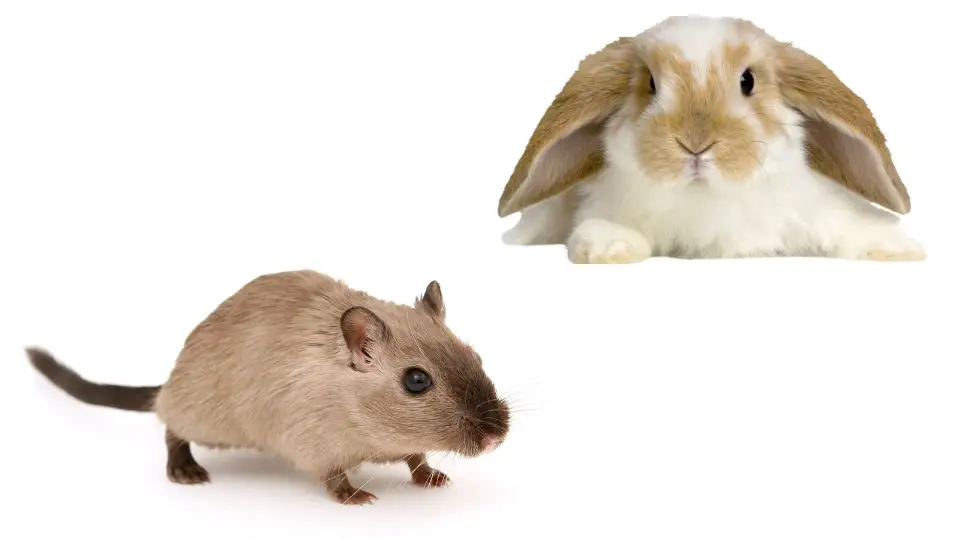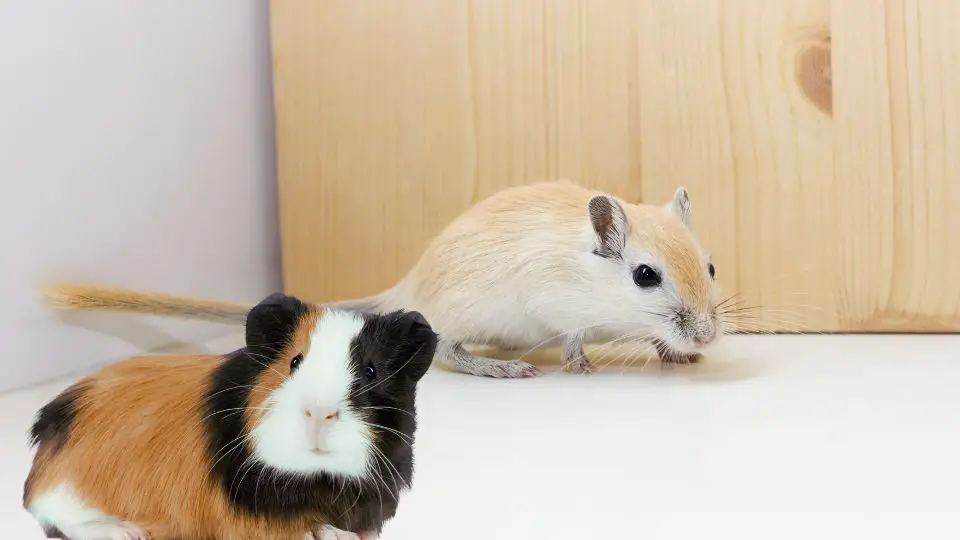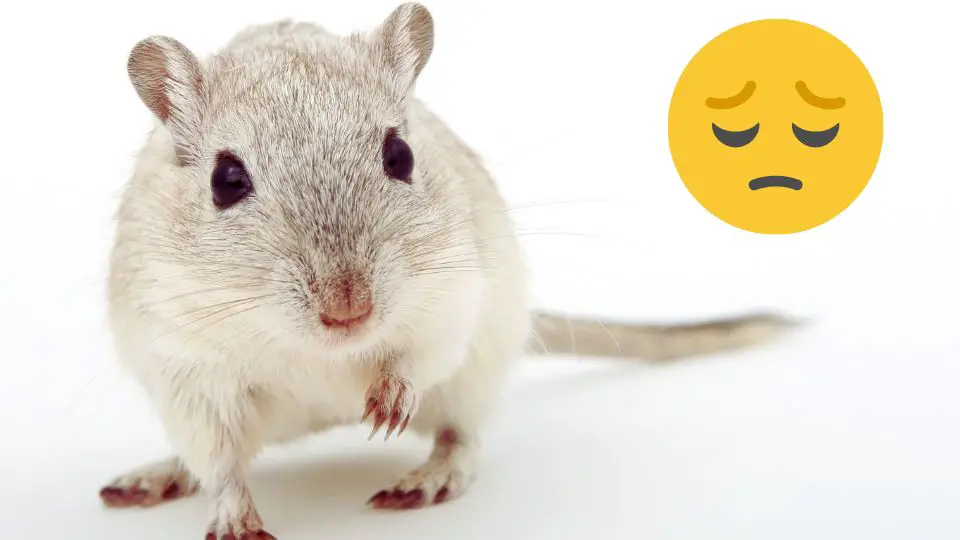If you are looking for a furry friend to keep your pet company, you might be wondering if gerbils and rabbits can get along.
Some gerbils and rabbits can play together successfully but it depends on their character. It is best not to allow your gerbil to play together with a rabbit as they could sustain injuries.
In this article, we will explore the pros and cons of keeping gerbils and rabbits together, as well as some tips on how to make their interaction safe and enjoyable for both animals.
Do Gerbils and Rabbits Get Along?
Gerbils and rabbits are both cute and friendly pets, but they don’t always get along well. They are different animals that come from different parts of the world, and they have different needs and behaviors. Gerbils are small rodents that like to live in groups, while rabbits are larger lagomorphs that prefer a mate for life.
Gerbils and rabbits can sometimes play together, but they should never live together or be left alone unsupervised. They might get scared or aggressive and hurt each other. If you want to keep both gerbils and rabbits, make sure they have separate cages and enough space to exercise and explore.
Understanding Gerbil and Rabbit Behavior
Gerbils and rabbits are popular pets known for their unique behaviors and social tendencies. To ensure the well-being of these furry companions, it’s essential to understand their behavior and social structure.
Gerbil Behavior and Social Structure
Gerbils are social animals that naturally live in small family groups in the wild. They have a hierarchical social structure where a dominant male and female lead the group. Gerbils engage in various social behaviors, including grooming, playing, and scent marking. They communicate through vocalizations, body language, and scent cues. Gerbils form strong bonds within their social groups and rely on each other for companionship and security.
Rabbit Behavior and Social Tendencies
Rabbits, too, are social animals that exhibit complex behaviors. They are highly social creatures that thrive in the company of their own kind. In the wild, rabbits form intricate social hierarchies within their warrens. Rabbits engage in grooming, huddling, and playing to strengthen social bonds. They communicate through body language, vocalizations, and scent marking. Rabbits seek companionship and may exhibit signs of distress or loneliness when deprived of social interaction.
While gerbils and rabbits have similar social tendencies, you have to recognize that their behaviors are specific to their respective species. They have evolved different social structures and communication methods, which may impact their interactions with one another.
Understanding the behavior of gerbils and rabbits is crucial when considering their compatibility as pets. While they both have social needs, introducing them to one another requires careful observation and consideration. It’s essential to provide a safe and stress-free environment that allows for gradual introductions and supervised interactions.
Remember, the happiness and comfort of both gerbils and rabbits should always be prioritized, and their social needs should be fulfilled through suitable companionship and proper socialization practices.
Factors Affecting Gerbil-Rabbit Relation
When considering the compatibility between gerbils and rabbits as potential companions, several factors come into play.
Size and Strength Differences
Gerbils and rabbits have notable differences in size and strength. Rabbits are generally larger and more robust compared to gerbils. This size disparity can pose risks during interactions, as rabbits may unintentionally cause harm to gerbils due to their larger stature. You should carefully consider the potential impact of size and strength differences when contemplating gerbil-rabbit companionship.
Prey-Predator Instincts
Gerbils and rabbits have inherent prey-predator instincts that can influence their behavior towards each other. Gerbils, being prey animals, are naturally cautious and wary of potential threats, including larger animals like rabbits. Conversely, rabbits have predatory instincts and may view smaller animals like gerbils as prey.
These instincts can lead to stress, fear, or even aggression between gerbils and rabbits. Understanding and managing these instincts is essential for fostering a compatible and safe environment.
Socialization and Introductions
Proper socialization and introductions play a significant role in determining gerbil-rabbit compatibility. Slow and gradual introductions are vital to allow gerbils and rabbits to become familiar with each other’s scent, presence, and behavior. This gradual process helps them establish a sense of trust and comfort.
You have to closely monitor their interactions during the introduction phase and intervene if signs of aggression or distress arise. Seeking professional guidance from an experienced veterinarian or animal behaviorist can provide valuable insights and ensure a successful introduction process.
Potential Challenges and Risks
When considering the interactions between gerbils and rabbits, be aware of potential challenges and risks that may arise. These challenges include aggressive behavior and territoriality, injury risks due to size disparities, as well as hygiene concerns and disease transmission.
Aggressive behavior and territoriality
Both gerbils and rabbits have natural instincts and may exhibit territorial behavior. They may become aggressive to defend their space, resources, or establish dominance. Incompatibility between gerbils and rabbits can lead to aggression, which may result in physical harm.
It’s crucial to closely monitor their interactions and intervene if signs of aggression are observed. Separating them and providing them with their own individual spaces is essential for preventing injury and ensuring their well-being.
Injury risks due to size disparities
Gerbils and rabbits have notable differences in size, with rabbits being larger and more physically powerful. Size disparities can pose a risk of unintentional injury to gerbils during interactions or playtime. Even with the best intentions, rabbits may accidentally harm gerbils due to their larger stature and strength.
Ensuring supervised interactions and providing separate living spaces is crucial to minimize the risk of injury.
Hygiene and disease transmission
Maintaining good hygiene practices is important when considering the cohabitation or interaction between gerbils and rabbits. Different species may carry different pathogens or parasites that can be transmitted to one another. It’s essential to prevent direct contact between their feces, urine, and saliva.
Regular cleaning of their living areas and ensuring proper hygiene practices can minimize the risk of disease transmission.
Gerbil and Rabbit Interactions
When considering their interactions, carefully observe their initial interactions, identify signs of compatibility or aggression, and take necessary precautions to ensure their well-being.
Observe initial interactions
When introducing gerbils and rabbits, it’s crucial to closely observe their behavior and reactions to one another. During initial interactions, allow them to explore each other’s presence from a safe distance. Pay attention to their body language, vocalizations, and overall demeanor.
Signs of curiosity, relaxed postures, and positive exploratory behavior indicate a potential for compatibility. Conversely, signs of fear, aggression, or excessive stress should be taken seriously and may indicate an incompatibility between the two species.
Identify signs of compatibility or aggression
As gerbils and rabbits interact, you have to be vigilant in identifying signs of compatibility or aggression. Signs of compatibility include mutual grooming, gentle sniffing, and relaxed body language. These behaviors suggest a positive rapport and potential for a harmonious relationship.
On the other hand, signs of aggression may include chasing, biting, lunging, or aggressive vocalizations. If aggression is observed, it is crucial to separate the animals and seek professional guidance on how to proceed.
Supervise playtime and cohabitation considerations
If initial interactions show signs of compatibility, supervised playtime can be introduced to further gauge their interactions. Create a neutral and controlled environment where both gerbils and rabbits have enough space to retreat if needed. Maintain a watchful eye during playtime, intervening if any signs of aggression or distress arise.
Note that cohabitation between gerbils and rabbits can be challenging due to their different social structures and communication methods. Seek guidance from an experienced veterinarian or animal behaviorist if considering cohabitation.
Introducing Gerbils and Rabbits
If you’re considering introducing a gerbil to a rabbit, you should approach the process with care and patience. Here’s a beginner-friendly guide to help you introduce a gerbil to a rabbit:
Step 1: Prepare Separate Living Spaces:
Before introducing your gerbil and rabbit, make sure each has their own comfortable and secure living space. This will provide them with a safe retreat if they need some alone time.
Step 2: Familiarize Them with Each Other’s Scent:
To help your gerbil and rabbit become familiar with each other’s scent, you can exchange bedding or toys between their living spaces. This will help them get accustomed to the presence of the other animal.
Step 3: Neutral Territory:
Choose a neutral area for their first face-to-face interaction. This space should be free from any strong scents or territorial markings. A clean and spacious playpen or a neutral room can work well.
Step 4: Supervised Introduction:
With both animals in the neutral territory, observe their behavior closely. Keep a watchful eye to ensure their interaction remains calm and without any signs of aggression. If either animal shows signs of stress or aggression, separate them and try again later.
Step 5: Short and Positive Interactions:
Keep the initial interactions short, lasting only a few minutes. Gradually increase the duration over time as they become more comfortable with each other. Provide treats or their favorite food during these interactions to associate positive experiences with each other’s presence.
Step 6: Gradual Increase in Time Together:
As the gerbil and rabbit become more relaxed and accustomed to each other’s presence, gradually increase the duration of their supervised playtime. Always be prepared to intervene if any signs of aggression or stress arise.
Step 7: Continued Supervision:
Even as the gerbil and rabbit become more familiar with each other, you should supervise their interactions for an extended period. This will ensure their safety and help you address any potential conflicts early on.
Step 8: Gradual Cohabitation:
If you wish to have your gerbil and rabbit live together, you can gradually introduce them to the same living space. However, closely monitor their behavior and have separate areas within the shared space to allow for individual retreat.
Conclusion
In conclusion, the compatibility between gerbils and rabbits can vary depending on individual personalities, experiences, and the proper introduction process. While some gerbils and rabbits may form strong bonds and enjoy each other’s company, it’s crucial to remember that not all individuals will get along.
Their different sizes, behaviors, and social structures can present challenges and potential risks. It is essential to prioritize their safety, well-being, and individual needs when considering their interactions or cohabitation.







